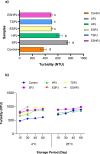Upcycling of Pomegranate By-Products: Pomegranate Juice Enrichment With Phenolics-Rich Pomegranate By-Product Extracts Obtained by Green Extraction Methods
- PMID: 40444126
- PMCID: PMC12121441
- DOI: 10.1002/fsn3.70250
Upcycling of Pomegranate By-Products: Pomegranate Juice Enrichment With Phenolics-Rich Pomegranate By-Product Extracts Obtained by Green Extraction Methods
Abstract
The objective of this study was to produce high-added-value and upcycled pomegranate juices (PJs) enriched with extracts obtained from pomegranate by-products using innovative green extraction methods. The physicochemical properties of PJs stored for 60 days at 4°C and 25°C were analyzed. The incorporation of extracts into the juice resulted in a notable enhancement in the bioactive content and antioxidant activity of the samples when compared to the control. Conversely, the addition of extracts into juices resulted in a reduction in L* value, appearance and color values, and elevated turbidity. The sensory evaluation indicated that the PJ containing extract obtained from enzymatic and solvent-assisted extraction exhibited the most sensory appreciation in terms of odor, taste, aftertaste, and general acceptability. The prolongation of storage time and elevation of temperature resulted in a decline in a*, b*, and hue angle values, accompanied by a reduction in phenolics, total monomeric anthocyanin, and antioxidant activity. All sensory properties of the samples decreased during the storage period. To maintain the quality of enriched PJs, they should be stored at 4°C. Consequently, the production of upcycled PJs with a high concentration of bioactive components and a sensory profile that was acceptable was achieved. Furthermore, enrichment of the PJ with H extract, with its low addition rate and brief extraction time, was an optimum option in terms of chemical, physical, and sensory properties and industry.
Keywords: enzymatic extraction; homogenization; phenolic compounds; pomegranate juice; storage; upcycling.
© 2025 The Author(s). Food Science & Nutrition published by Wiley Periodicals LLC.
Conflict of interest statement
The authors declare no conflicts of interest.
Figures

References
-
- Alighourchi, H. , Barzegar M., and Abbasi S.. 2008. “Anthocyanins Characterization of 15 Iranian Pomegranate ( Punica granatum L.) Varieties and Their Variation After Cold Storage and Pasteurization.” European Food Research and Technology 227, no. 3: 881–887. 10.1007/s00217-007-0799-1. - DOI
-
- Andishmand, H. , Masoumi B., Torbati M., Homayouni‐Rad A., Azadmard‐Damirchi S., and Hamishehkar H.. 2023. “Ultrasonication/Dynamic Maceration‐Assisted Extraction Method as a Novel Combined Approach for Recovery of Phenolic Compounds From Pomegranate Peel.” Food Science & Nutrition 11, no. 11: 7160–7171. 10.1002/fsn3.3642. - DOI - PMC - PubMed
-
- Andrade, M. A. , Lima V., Silva A. S., et al. 2019. “Pomegranate and Grape By‐Products and Their Active Compounds: Are They a Valuable Source for Food Applications?” Trends in Food Science & Technology 86: 68–84. 10.1016/j.tifs.2019.02.010. - DOI
LinkOut - more resources
Full Text Sources

